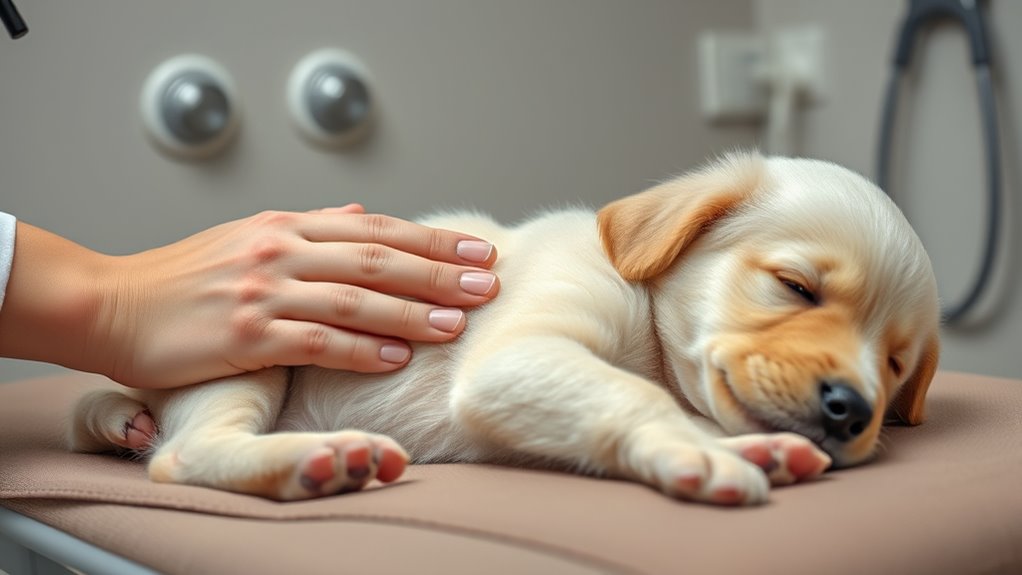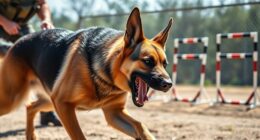To get your puppy comfortable with touch for vet visits, start by gradually introducing handling during playtime with gentle touches to their paws, ears, and tail. Use treats and praise to create positive associations, and keep sessions short and calm. Practice handling specific areas safely and gently, rewarding your pup for relaxation. Regular exposure and consistent routines help normalize touching, making vet visits less stressful—keep going to discover more effective techniques for building trust and confidence.
Key Takeaways
- Gradually introduce handling of paws, ears, and mouth during calm moments with treats and praise.
- Use short, positive handling sessions regularly to build trust and reduce stress during vet visits.
- Incorporate handling exercises into playtime, rewarding calm behavior to create positive associations.
- Familiarize your puppy with grooming tools and gentle restraint to normalize vet procedures.
- Observe body language cues to respect boundaries and avoid forcing touch, ensuring a relaxed and confident puppy.
Understanding Your Puppy’s Comfort Zones

Understanding your puppy’s comfort zones is essential for building trust and ensuring smooth vet visits. Pay close attention to their body language to gauge how they’re feeling. Signs like a relaxed tail, soft eyes, or a calm stance indicate comfort, while stiff muscles, pinned-back ears, or tucked tail suggest stress. Recognize that some puppies are more noise sensitive, reacting strongly to loud sounds or sudden noises. By observing these cues, you can identify when your puppy feels uneasy and adjust accordingly. Respect their boundaries and don’t force interactions when they show signs of discomfort. Gradually exposing them to different stimuli in a positive way helps expand their comfort zone, which is crucial for reducing anxiety during veterinary visits. Incorporating desensitization techniques can also aid in easing their fears and creating a more positive experience. Understanding animal body language and how it reflects their emotional state can significantly improve how you support your puppy through stressful situations. Color accuracy impacts the overall image quality, which can influence how your puppy perceives their environment during visits. This understanding creates a foundation of trust, making vet visits less stressful for both you and your puppy.
Creating Positive Associations With Touch
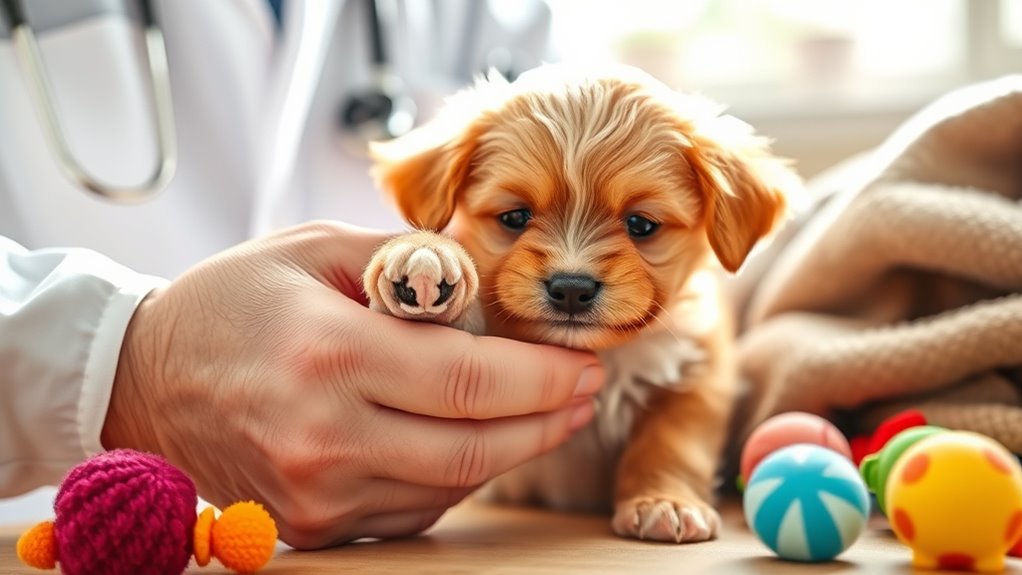
Creating positive associations with touch is essential for making vet visits and handling less stressful for your puppy. Start by incorporating gentle handling during puppy socialization, so your dog learns that being touched is safe and pleasant. Use handling equipment like brushes, grooming tools, and even your hands to gently touch different parts of your puppy’s body regularly. Reward your puppy with treats and praise whenever they tolerate or enjoy handling. Keep sessions short and positive, gradually increasing duration to build comfort. Consistent, calm interactions help your puppy associate touch with positive experiences. Incorporating positive reinforcement techniques can help you understand what methods your puppy responds best to, ensuring a tailored approach. Understanding behavioral conditioning is key to creating lasting positive associations with touch. Repetition and desensitization are effective strategies for reducing sensitivity to touch over time. Additionally, introducing counter-conditioning can help change your puppy’s emotional response to handling situations. Over time, these associations will make vet visits and grooming easier, reducing fear and resistance during future handling. The goal is to create a foundation of trust and ease with touch that lasts a lifetime.
Gradual Desensitization Techniques
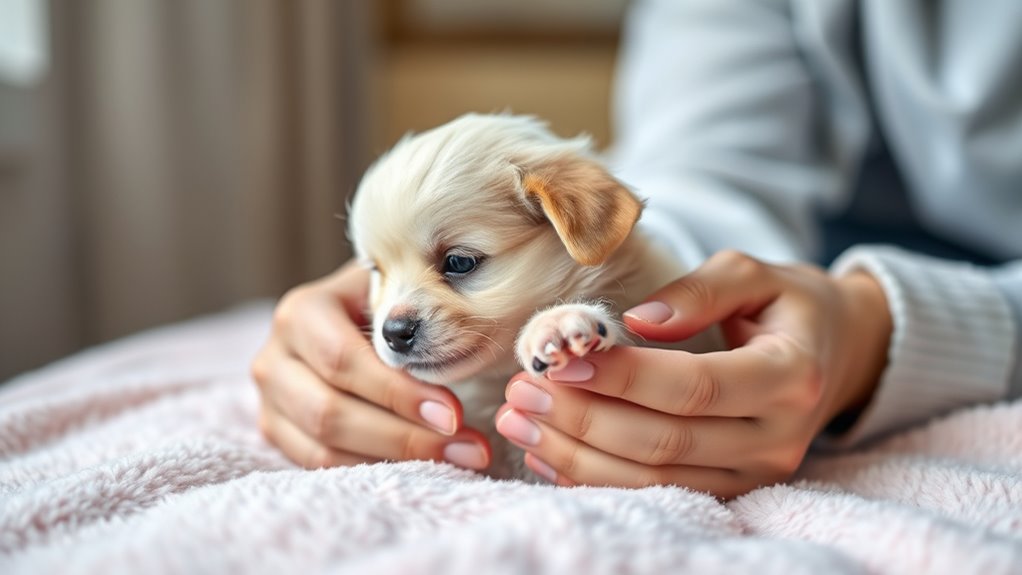
Gradual desensitization is an effective way to help your puppy become comfortable with handling and vet procedures. Start by gently introducing massage techniques during calm moments, focusing on areas like paws, ears, and tail. Use soft, reassuring touch to build trust and associate handling with positive experiences. Incorporate grooming routines gradually, touching your puppy’s body in short sessions, then slowly increasing the duration over time. Keep these sessions relaxed and rewarding with treats and praise. If your puppy shows signs of discomfort, back off slightly and return to a more comfortable level before progressing again. Consistency is key—regular, gentle exposure helps your puppy become accustomed to being touched, making vet visits less stressful and handling easier for both of you. Building trust through consistent positive interactions can further enhance your puppy’s comfort with handling. Recognizing signs of fatigue and ensuring proper hydration can also contribute to a more positive experience during handling and vet visits. Additionally, understanding Vetted – AP Tuning can help you select the best tools or products to make grooming and handling smoother. Incorporating mindfulness practices during these sessions can help both you and your puppy stay calm and focused, reducing overall stress during vet visits. Using exfoliation techniques like gentle brushing can also help your puppy feel more comfortable with touch and handling.
Incorporating Handling Into Playtime
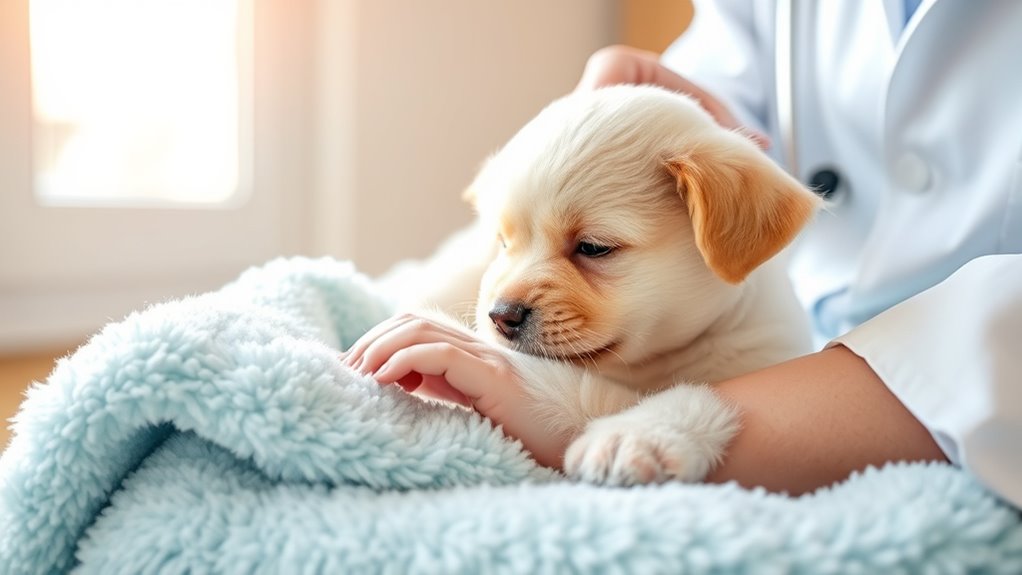
You can make handling a positive experience by turning it into gentle touch games during playtime. Use positive reinforcement like treats or praise to reward calm behavior. This approach helps your pet associate handling with fun and comfort. Incorporating social cues into your training can further improve your puppy’s responsiveness to handling. Consistently practicing these techniques can also help develop your puppy’s trust and confidence during veterinary visits.
Gentle Touch Games
Gentle Touch Games are a fun and effective way to help your pet become comfortable with handling during vet visits. By turning touch into a game, your puppy learns to enjoy paw massages and gentle brushing without stress. Start by softly massaging their paws, rewarding calm behavior with praise or treats. Incorporate gentle brushing into playtime, making it a positive experience rather than a chore. Use slow, gentle strokes to avoid startling your puppy. Keep sessions short and frequent, gradually increasing the duration as your pup becomes more relaxed. These games build trust and teach your puppy that handling is safe and pleasant. Additionally, understanding desert-themed treats can motivate your puppy during training sessions, making the experience even more enjoyable for them. Engaging your puppy in positive reinforcement techniques ensures they associate handling with rewarding experiences, which further reduces anxiety and helps them develop a trusting attitude towards touch. Incorporating calming environments can also help make these sessions more successful.
Positive Reinforcement Techniques
Incorporating handling into playtime using positive reinforcement creates a rewarding experience for your puppy, making them more receptive to being touched and examined. During play, gently introduce handling equipment like brushes or treats, pairing them with praise to build positive associations. This approach supports puppy socialization by helping your pup see handling as a normal, non-threatening part of life. Reward calm behavior consistently, offering treats or praise whenever your puppy allows touch on sensitive areas like paws or ears. Over time, this reinforcement strengthens trust and reduces fear during vet visits. Keep sessions short and fun, gradually increasing the duration of handling. Additionally, practicing handling during playtime can help your puppy become accustomed to vet procedures, making future training sessions smoother and more effective. Incorporating these techniques can also promote positive water-based interactions, which are beneficial for both physical comfort and emotional well-being. Understanding the importance of early socialization can further enhance your puppy’s comfort with handling and new experiences. Moreover, understanding the benefits of positive reinforcement can motivate consistent training efforts and foster a stronger bond between you and your puppy.
Using Rewards and Praise Effectively
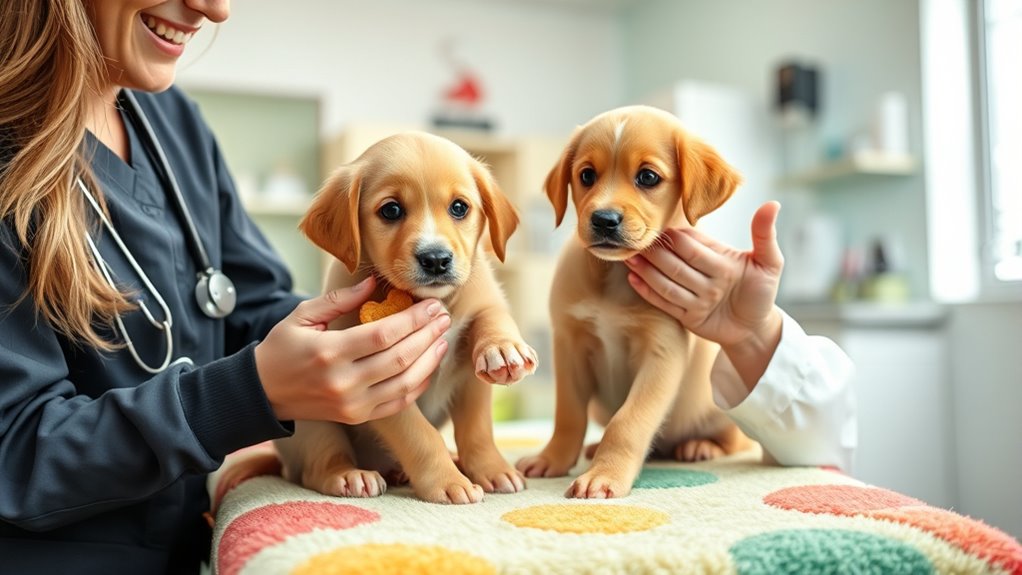
Using rewards and praise can markedly improve your pet’s cooperation during vet visits, but effectiveness depends on timing and consistency. To do this well, focus on treat timing—give treats immediately after your puppy remains calm or performs a desired behavior. This ensures they connect the reward with the appropriate action. Additionally, use clear verbal cues like “good boy” or “yes” consistently to reinforce positive behavior. When your pup stays relaxed or allows handling, praise them enthusiastically and promptly. Consistent timing helps your puppy understand which actions earn rewards, making future cooperation more likely. Remember, immediate reinforcement is key—wait too long, and your puppy may not associate the reward with the behavior. With patience and consistency, rewards and praise become powerful tools for easing vet visits. Embracing a bias to action approach can also help you respond swiftly to your puppy’s needs and reactions during these situations.
Handling Specific Areas Safely and Comfortably
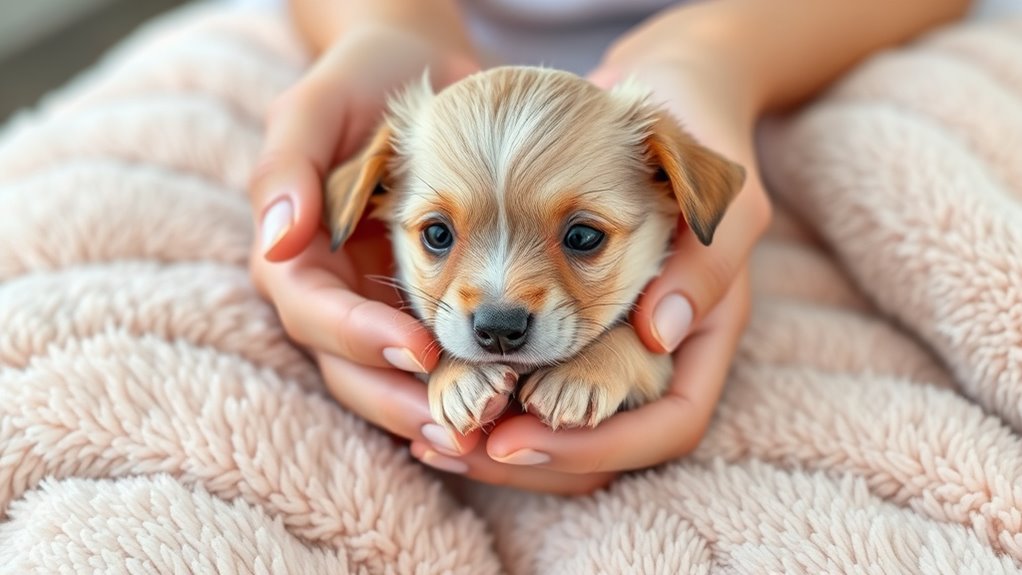
Handling specific areas of your pet safely and comfortably is essential for reducing stress and preventing injuries during vet visits. Start by gently touching your puppy’s paws, ears, tail, and mouth regularly to make these areas familiar. During puppy grooming, use calm, slow motions and reward your pup to create positive associations. When handling emergencies, stay calm and handle the affected area carefully to avoid causing pain or panic. Always support delicate areas like the joints and avoid forcing your puppy into uncomfortable positions. Consistent, gentle handling builds trust and helps your puppy tolerate touching and handling in a calm, safe manner. This approach ensures that both routine grooming and unexpected situations are managed smoothly, making vet visits less stressful for everyone involved.
Preparing Your Puppy for Vet Visits
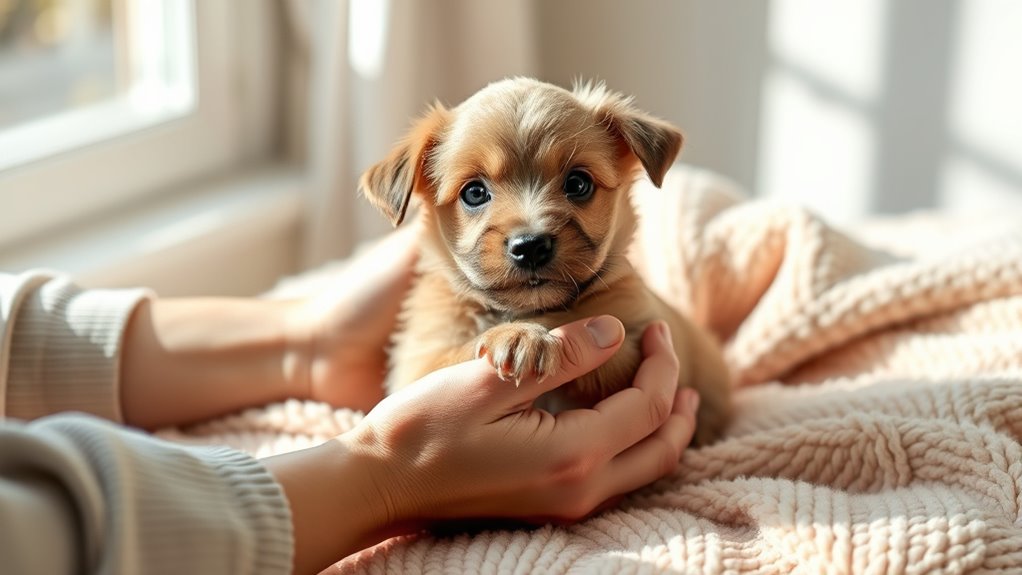
Preparing your puppy for vet visits starts well before the appointment day. Early puppy socialization helps your pup become comfortable around new people, sounds, and environments, reducing anxiety during vet trips. Introduce your puppy to different handling experiences gradually, pairing them with positive reinforcement like treats and praise. Incorporate grooming routines into your daily interactions so your puppy is accustomed to being touched in areas like paws, ears, and mouth. This familiarity makes vet exams smoother and less stressful. Practice gentle restraint and handling at home, simulating vet procedures, to build your puppy’s confidence. Consistent exposure to different situations and touch will help your puppy see vet visits as normal, calming their nerves and making future appointments easier for both of you.
Frequently Asked Questions
How Can I Tell if My Puppy Is Genuinely Comfortable or Just Tolerating Touch?
When wondering if your puppy is genuinely comfortable or just tolerating touch, observe their body language. Signs of true puppy relaxation include loose muscles, a wagging tail, and soft eyes. If your puppy pulls away, tenses up, or shows signs of stress, they’re just tolerating touch. Building trust gradually helps improve their touch tolerance, making interactions more positive and comforting for your puppy.
What Are Signs My Puppy Is Stressed During Handling or Vet Visits?
Did you know 55% of dogs show stress through body language and vocal cues? During handling, you’ll notice signs like lip licking, yawning, pinned-back ears, or trembling. Vocal cues such as whimpering, whining, or growling also indicate discomfort. Recognizing these signs helps you respond calmly, making your puppy feel safer and more relaxed, ultimately easing future vet visits and handling sessions.
How Often Should I Practice Handling Exercises to Ensure Progress?
To guarantee steady progress, practice handling exercises with your puppy regularly, ideally daily or every other day. Maintain consistency in your approach, gradually increasing exposure to different touches and situations. Keep sessions short and positive, celebrating successes to build confidence. Over time, this frequency consistency helps your puppy become comfortable with touch, making future vet visits less stressful. Remember, patience and gradual exposure are key to effective training.
Are There Specific Toys or Tools That Help Puppies Become Accustomed to Touch?
You might worry that toys won’t make a difference, but they really do help your puppy get used to touch. Try using interactive toys and grooming tools to create positive associations. These tools encourage gentle handling and build confidence. Regularly introducing them in a calm environment helps your puppy associate touch with fun, making future vet visits and grooming much easier and less stressful for both of you.
How Can I Handle a Puppy That Is Particularly Nervous or Aggressive?
When your puppy is nervous or aggressive, focus on building their confidence through gentle handling techniques. Stay calm, speak softly, and use positive reinforcement to reward calm behavior. Gradually introduce touch, starting with brief sessions and increasing gradually as they become more comfortable. Consistency is key; over time, your puppy will learn to trust your handling and become more relaxed during interactions.
Conclusion
By making handling a positive experience, you build trust and confidence in your puppy. It’s easy to focus on the importance of calm vet visits, but remember, every gentle touch at home shapes their comfort in the exam room. While you teach patience and care, you also create a bond that lasts a lifetime. In calming your puppy’s fears, you’re not just preparing for vet visits—you’re nurturing a confident, happy companion for years to come.

